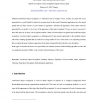Free Online Productivity Tools
i2Speak
i2Symbol
i2OCR
iTex2Img
iWeb2Print
iWeb2Shot
i2Type
iPdf2Split
iPdf2Merge
i2Bopomofo
i2Arabic
i2Style
i2Image
i2PDF
iLatex2Rtf
Sci2ools
99
Voted
EWCBR
2004
Springer
2004
Springer
Case-Based Object Recognition
Model-based object recognition is a well-known task in Computer Vision. Usually, one object that can be generalized by a model should be detected in an image based on this model. Biomedical applications have the special quality that one object can have a great variation in appearance. Therefore the appearance of this object cannot be generalized by one model. A set of cases of the appearance of this object (sometimes 50 cases or more) is necessary to detect this object in an image. The recognition method is rather case-based object recognition than model-based object recognition. Case-based object recognition is a challenging task. It puts special requirements to the similarity measure and needs a matching algorithm that can work fast on a large number of cases. It also needs a case acquisition procedure that can capture the great variation in appearance of an object and generalize these data into a case description. In this paper we describe the chosen case representation, the similar...
Artificial Intelligence | Case-based Object Recognition | EWCBR 2004 | Model-based Object Recognition | Object Recognition |
Related Content
| Added | 01 Jul 2010 |
| Updated | 01 Jul 2010 |
| Type | Conference |
| Year | 2004 |
| Where | EWCBR |
| Authors | Petra Perner, Angela Bühring |
Comments (0)

